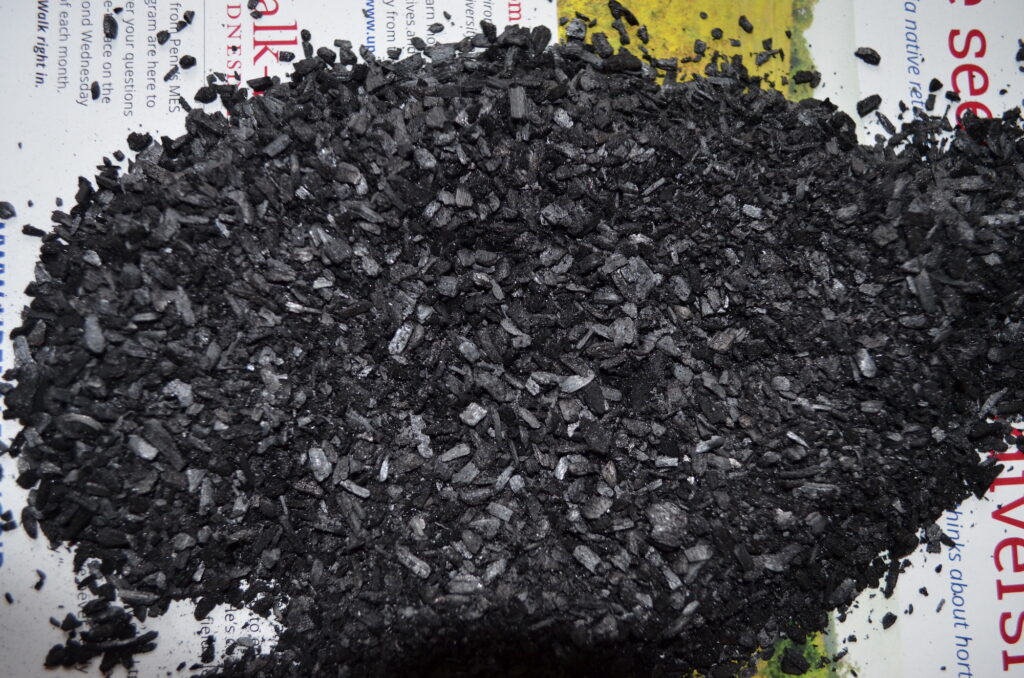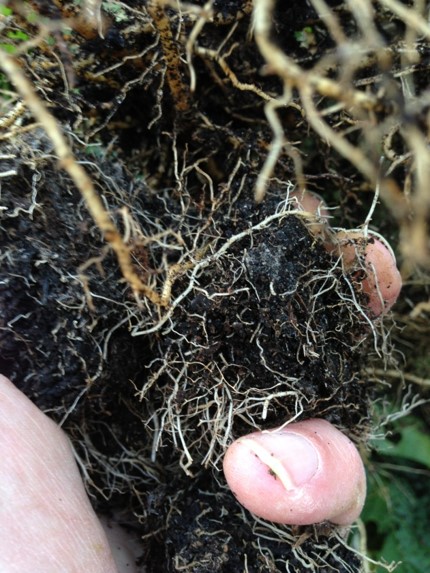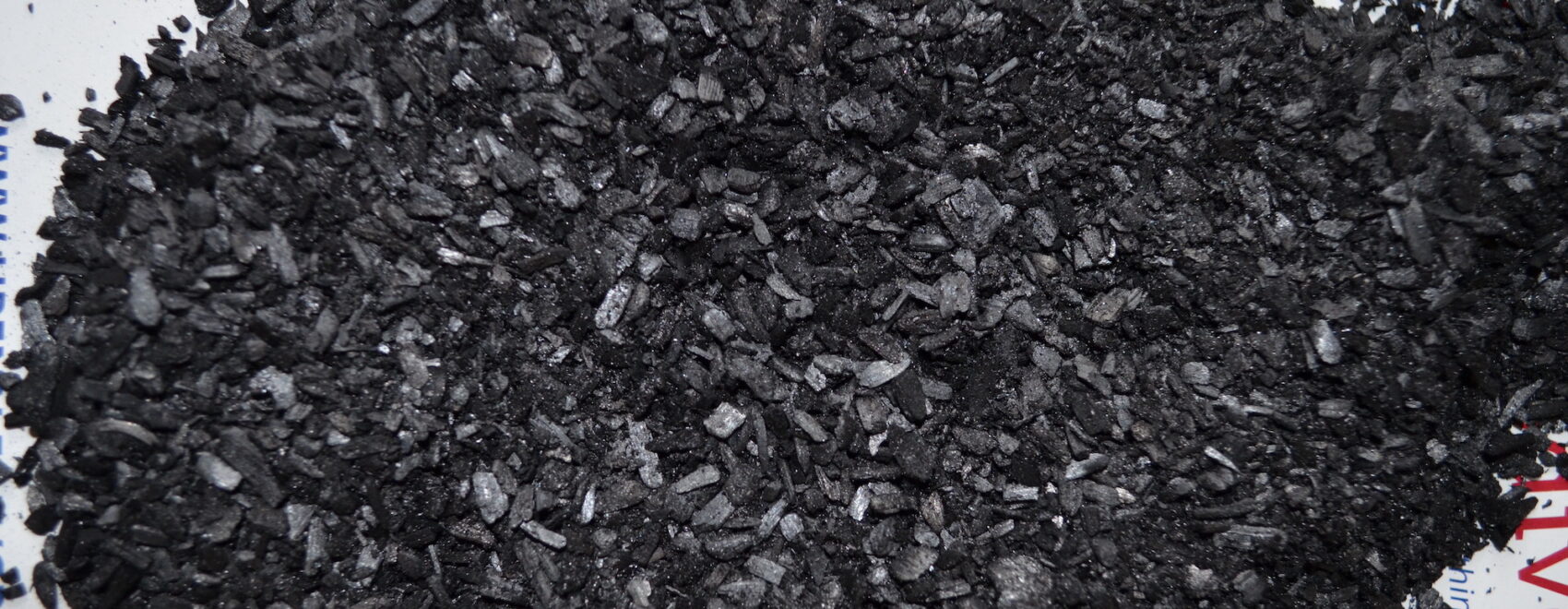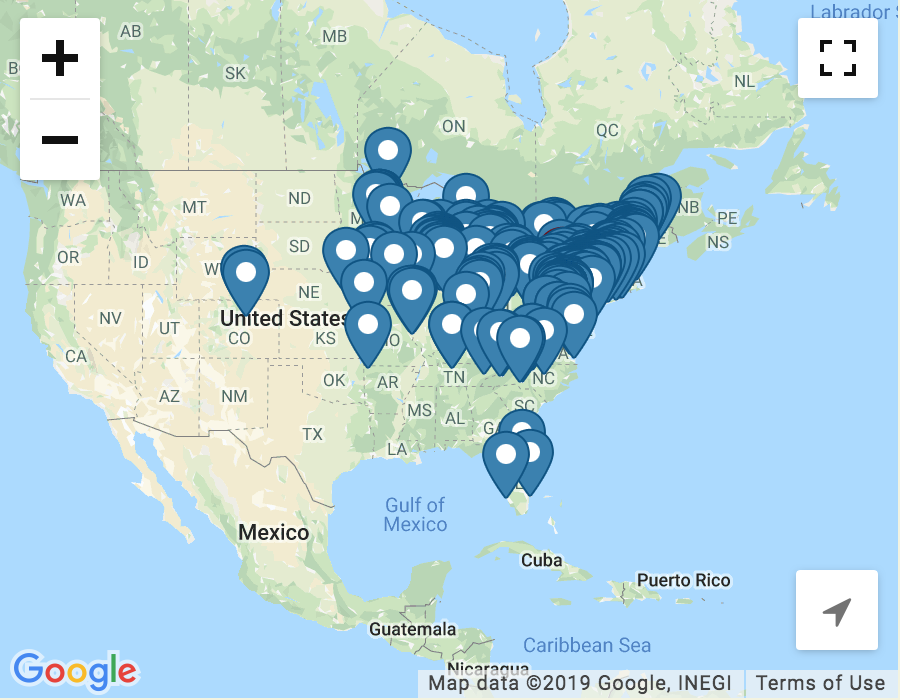We’re doing something a little different with this month’s blog post. We’ve interviewed Mark Highland, Founder of Organic Mechanics, about one of the oldest yet newest concepts in horticultural soil health. Mark is a major proponent of the recent biochar movement in the U.S. The Biochar Boss shares his wealth of knowledge about biochar, and in words and terms non-soil scientists can easily understand.
Read on for your primer on biochar, the burnt stuff that could help save the planet.
Ellen Wells: What exactly is biochar? I’m sure it’s not like when you burn your steak.
Mark Highland: It is different from that, yes. Biochar is essentially carbon, so any organic matter burned in the absence of oxygen and the resulting product is pure carbon and is a soil amendment. It’s used to help retain moisture, retain nutrients, it’s a home for beneficial biology and it lasts practically forever in terms of a human lifetime, it’s a lifetime soil amendment. Apply it once and you’ll get all the benefits for years to come.
EW: Explain if there are different types of biochar and what kind of biochar do you use in your products?
MH: That’s a great question. There are a lot of different types of biochar. It depends on what it’s made from, how it’s made – meaning the temperature it’s cooked at, the residence time inside a kiln or furnace do have a direct effect on the resultant characteristics of the biochar. We use softwood biochar, made from waste from the pine industry, sustainably sourced from local Virginia tree farms. Ours is produced under conditions that result in a near neutral pH, high carbon content, and high surface area for maximum soil benefit.
EW: Give us a little history of biochar—where did it come from, who discovered it?
MH: Biochar has been around a long time. Terra preta of the Amazon is where it was rediscovered. There’s a whole BBC documentary on biochar. But scientists are looking at these soils in the Amazon where tropical soils are typically thinner soils not as productive as others and so a long time ago people figured out that if they put this wood biomass-based product burned in the absence of oxygen, that it would help to hold nutrients and make these tropical soils more productive. When USDA researchers went down to the Amazon to do testing on the carbon that was there, carbon-dating it they found it to be more than 2,000 years old and the carbon was still in the soil helping to improve the soil structure, soil quality, just the whole rhizosphere of the soil and its environment. So, take that application forward and really worldwide there are a lot of companies and people working with biochar and putting biochar into landscapes, agricultural operations. There are other applications for it as well, but in terms of horticulture, it’s a soil amendment to improve plant growth, plant health and soil health.
EW: What exactly is it doing in the soil and what does biochar do for the plant?
MH: Biochar is carbon, pure carbon. All of the things that are more flammable are burned away. It’s a pure kind of crystalline carbon structure, carbon rings that stack up. The quality of the biochar is directly related to the amount of carbon that is present, because it’s the carbon that’s doing the work. Our biochar is over 90% carbon! This is very good also for carbon sequestration, keeping that carbon in the ground. How does it work and why is it so great? You put this carbon in the form of biochar in the ground and it’s going to absorb water and nutrients, it’ll be home for beneficial biology, but it’ll also have a very high cation exchange capacity. That is how it’s hanging on to those nutrients. It will complex with the soil, between the microbes, the soil particles, the nutrients—it forms a complex that basically holds on to those nutrients until the microbes want to get in there and pull off the nutrients and feed it to the plants or use it for the microbes’ own growth and reproduction.
EW: So, it’s like a little safe in the soil until the microbes unlock it and take that good stuff out and use it.
MH: You got it!

This is raw biochar. It may be small but it’s got such a good amount of surface area to hold all the good stuff for microbes and plants!
EW: Does biochar have applications for other things?
MH: Anytime a terrarium mix calls for a charcoal layer you can use 100% pure biochar. There are other applications, for example it can be used on equestrian farms and farms in general, for bedding material. That way it captures a lot of those nutrients that might otherwise be lost. So it’s great for the farming industry. It has a lot of other uses, as well. It’s used in construction to make concrete lighter and stronger. But for us horticulturists, definitely using it in the ground or in containers to amend potting soil are great uses for it.
EW: I hear it’s a great tool in our fight against climate change. Give me a synopsis of why.
MH: When we have waste materials what are we going to do with that? Composting certainly comes to mind. There’s lots of composting going on. At the same time, when we make biochar from organic materials as opposed to composting it—we still need to compost, don’t get me wrong, there’s plenty of carbon for both uses—but there’s enough available waste carbon to be recycled into something else so we should be making biochar with these waste products. With carbon sequestration, when we put biochar in the ground, for every ton of material that is sequestered, you’re essentially put in almost three tons of carbon in the ground. It has to do with how much this material weighs to start with versus what it weighs once it’s cooked, once all the flammable things have been burned off, the moisture is burned out of it. Three tons of wood chips is about one ton of biochar going into the ground. Once it’s in the ground it’s going to sit there for at least a human lifetime. We can’t promise two thousand years as the USDA proved but we do say that within a human lifetime you won’t have to add it again once you add it at the recommended rate.
EW: How should gardeners use biochar?
MH: Biochar is a raw uninoculated product. It needs to be inoculated, or charged up. Meaning, we need to fill all those exchange sites because it does have a very high cation exchange capacity, the ability to hang on to nutrients in soil. So we have to inoculate it first. Organic Mechanics’ Biochar Blend is a good example of that. We mix it with some compost, earthworm castings, kelp meal, alfalfa meal, bone char (spent bone black), zeolite, and azomite (volcanic ash) and that is to essentially charge it up and you can use it in your garden right away. If you did put pure biochar in a garden, that is going to absorb nutrients out of the soil and if you do it in a garden area where there’s already plants, you’ll notice those plants will yellow. You don’t want that. So we don’t want to use raw biochar straight in our gardens. We want to use a product like the Biochar Blend that is pre-inoculated and ready to use right out of the bag and will enhance the soil, so that’s a big difference between the two. As far as the application rate goes, the Biochar Blend is designed to be used at a 10% rate by volume. So if you have a 10-gal. pot, you would want 1 gal. of the Biochar Blend to go into that soil mixture and just mix it up. If you’re using it in a vegetable garden, you put it down in a half-inch layer, and one cubic foot will cover about 24 sq. ft. So a 3 ft. x 8 ft. raised bed, you just put on a half-inch layer and you lightly mix it into the soil.
EW: You’d have to do this every year or no?
MH: If you apply our Biochar Blend at the 10% rate, you’re essentially putting all you need in the soil and won’t ever need to add it again but you do get those benefits year after year. And it’s not the same price as just a bag of compost at your local store or online, it’s a little more than that. But what you’re getting is permanent value. When you stretch it out over the years, it’s totally worth it. A lot of people say, “Oh well I can’t do all my garden beds this year because it’s not cheap but I want to try it.” We recommend people try it! Put it in one garden bed. Plant the same plants in A bed and B bed and see what happens. We guarantee you’ll notice a difference. You can do a little bit of your garden each year until it’s all covered.
EW: A-B testing, it’s such a gardener thing! Do you have biochar in any other products that you carry, other than the Biochar Blend?
MH: We do, actually. We are launching our 110 Blend in the spring of 2024, so it’ll be available in January. It already has that 10% Biochar Blend by volume mixed into the potting soil so you don’t have to mix it and mess with it. You just open one of those bags and plant away because biochar is already incorporated. We’re really excited about that product. It makes it really easy for gardeners to use it. We also put biochar in our Cactus & Succulent Blend. That blend is unlike any other on the market, and that’s because we use a lot of rocks. There’s shale, there’s sand and it creates very unique pore spaces so a lot of cacti and succulents draw the moisture from between those pore spaces, and the biochar helps with a little moisture retention with all of those rocks in that mix. That’s one of the keys to its performance in that blend. And there’s our first biochar-enhanced product, the Fuhgeddaboudit! Root Zone Feeder Packs! They’re super simple to use and really help with reducing plant stress from transplanting.

This is a Fuhgeddaboudit Root Zone Feeder Pack after coming out of the ground at the end of the season. This pepper plant’s roots are heavily branched and concentrated around and throughout the feeder pack, as compared to the surrounding soil.
We may put it in other blends as time goes on, but it’s just so easy to put into any of our products. You can mix the Biochar Blend with our Container Blend soil. You can mix it with our Seed Starting Blend—biochar has been shown to enhance seed germination. You can mix the two together and we leave that up to the gardeners where they can customize and use it in their gardens as they want as opposed to putting it in all the products.
EW: Can you use it for houseplants?
MH: 100%. I think it’s a great amendment for houseplant soils simply because a lot of times especially in winter houseplants can be dry and the soil can dry out—it’s important to let it dry between waterings—but putting that Biochar Blend in a houseplant potting soil is really going to perk that plant up and have it look better than ever.
EW: Is there anything else you wanted to say about biochar?
MH: When you talk about incorporating biochar into existing beds, there’s really sometimes no options to till or disturb the soil. I mean, you don’t want to disturb plants’ roots. We’ve had landscape customers in those cases use it very successfully by putting biochar down as a topdress and adding a mulch layer over time – a layer of wood chips, a layer of compost, whatever your favorite mulch is. That will hold the biochar in place and it will slowly work its way into the soil, providing some of those benefits. Biochar has so many benefits, we’ve only scratched the surface. There’s benefits for geotechnical engineering. Use it in stormwater soil applications. And biochar has this incredible property to be an electron donor or an electron acceptor, which helps to drive the biogeochemical equations in soil. So it can really help to push things forward with nutrient availability and just any kind of reactions happening in the soil.
EW: So, we’re still unlocking the secrets of biochar. There may be something we don’t even know about yet.
MH: 100% I agree with that! There’s been renewed interest in biochar in the last 10 years. I would say there’s been more and more studies. Ten years ago if you went to see how many scientifically peer-reviewed articles there were on biochar, there may have been a few hundred. Fast forward five years and all of a sudden there’s 10,000. Today, over 30,000. There are so many studies being done on biochar. And one of the biggest things about biochar is that you have to characterize where it came from and how it was made—temperature and residence time in a kiln or furnace. That has a very large effect on the qualities of the biochar. But technically, in the U.S., biochar must contain at least 60% carbon to be marketed as biochar. If it’s less, it’s technically known as wood ash. People ask me this a lot: “The stuff I clean out of my wood stove, is that biochar?” Probably not, because if you find any cinders in there, it’s probably biochar-like but it’s not quite the same thing. The people who are commercially making biochar, they are stopping the process at the right time where you maximize your biochar benefits. And you can make it yourself at home—there are some tutorials online — however you don’t get a very large volume of material and it’s also probably not the particle size that will be the most beneficial. With biochar, the greater the surface area, the more reactions that can happen, the more nutrients it can hold. For example, ours is the size of grains of rice, between the sizes of 3mm-9mm. That has a very high surface area so there’s a lot of benefit to buying a commercially made biochar as opposed to making it at home. By all means you should try it at home, you certainly have a lot of safety issues to think about—it is fire, after all—but how much fun is it to make a soil amendment while making some hot cocoa or baking some potatoes while you’re doing it?
EW: If folks want to buy biochar from Organic Mechanics, where would they go?
MH: We have the raw pure biochar available for landscape contractors and people who are doing green stormwater installation. But for gardeners, people who want to open the bag and use it right away, that’s our Biochar Blend. You can find that on our website at organicmechanicsoil.com. We have a shopping cart where you can add it to your cart and get it that way. But of course your local garden center is a great place to ask for Organic Mechanics Biochar Blend. A lot of our customers carry it but not all of them carry it. And if you need to know who is close to you that carries the Biochar Blend, you can always call our office and ask that question or we also have a “Where to Buy” locator on our website and you can just type in your address and find who is close. Look for a garden center and/or a hardware store to ask. A lot of the natural food stores that we sell to don’t carry our Biochar Blend but a lot of the garden centers do.
EW: Thank you very much, Mark!




